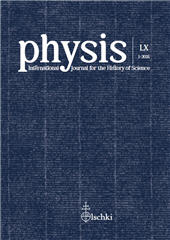From the Instrument to the Monument : Musealization and Museography of Scientific Instruments in the ‘Tribuna di Galileo' (1829-1879)
P. 237-262
The ‘Tribuna di Galileo,' was conceived by Vincenzo Antinori in 1829 and inaugurated in 1841. This study traces the evolution of the project, focusing on the role of scientific instruments within this new exhibiting space. It analyzes its design, functions, and role within scientific collections and 19th century museography. Antinori's original project reflected an innovative historical-scientific vision, organizing instruments chronologically to illustrate the progress of science. However, with its inauguration in 1841, the Tribuna transformed into a celebratory monument dedicated to Tuscany's scientific tradition, adorned with impactful pictorial and sculptural decorations. The second half of the 19th century marked a significant shift in the conception of scientific collections, in parallel with the rise of grand universal exhibitions.
In this context, Ferdinando Meucci, director of the Museum of Antique Instruments from 1874, and still overlooked by scientific literature, introduced an approach to the collections that balanced the educational function and aesthetic value of the instruments. The acquisition of Eustachio Porcellotti's pendulum clock model in 1877 exemplifies this transition: the model not only demonstrated the practical application of Galileo's invention but also served as an educational tool for an increasingly diverse audience. This balance between educational purpose and historical value is reflected in the Museum's participation in the Special Loan Collection held in London in 1876, where instruments and drawings from the Tribuna were exhibited, including a copy of the drawing of Galileo's application of the pendulum to clock attributed to his pupil Vincenzo Viviani or his son Vincenzio Galilei.
The choice to present a drawing instead of an instrument highlights the importance of visual and symbolic aspects in the scientific communication of the era. The analysis shows how, over the century, the Tribuna shifted from being a monumental celebratory space to a platform for valuing scientific and technical heritage. Despite its separation from the Museum, the Tribuna's role in preserving instruments has been crucial. This process culminated in the First National Exhibition on the History of Science in 1929 (Prima esposizione nazionale di storia della scienza), exactly a century after Antinori's original project. Ultimately, the study of the Tribuna di Galileo reveals the evolution of exhibition practices and the perception of scientific heritage, emphasizing how the preservation and celebration of instruments have contributed to maintaining and transmitting a dynamic and changing vision of the history of science. [Publisher's text]
73353 characters
-
Articoli dello stesso fascicolo (disponibili singolarmente)
-
Informazioni
Codice DOI: 10.1400/300590
ISSN: 2038-6265


